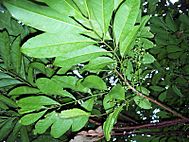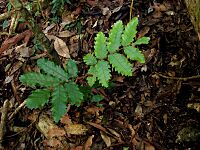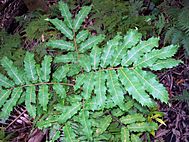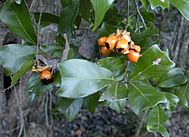Cupaniopsis facts for kids
Quick facts for kids Cupaniopsis |
|
|---|---|
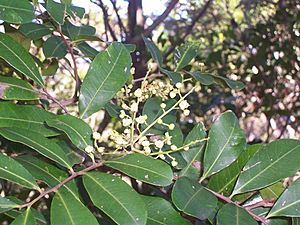 |
|
| Cupaniopsis anacardioides, Tuckeroo, with leaves and flowers, in Wyrrabalong National Park, NSW, Australia | |
| Scientific classification |
|
| Kingdom: | Plantae |
| Clade: | Tracheophytes |
| Clade: | Angiosperms |
| Clade: | Eudicots |
| Clade: | Rosids |
| Order: | Sapindales |
| Family: | Sapindaceae |
| Subfamily: | Sapindoideae |
| Genus: | Cupaniopsis Radlk. |
| Type species | |
| Cupaniopsis anacardioides (A.Rich.) Radlk.
|
|
| Species | |
|
See text |
|
Cupaniopsis is a genus (a group of related plants) that includes about 67 different kinds of trees and shrubs. They are part of the Sapindaceae family, also known as the soapberry family. These plants grow naturally in places like New Guinea, New Caledonia, Australia, the Torres Strait Islands, Fiji, Samoa, Sulawesi, and Micronesia.
Many Cupaniopsis species are in danger of disappearing forever. Important groups like the International Union for Conservation of Nature (IUCN) and different governments are working to protect them.
In Australia, some Cupaniopsis species are commonly called Tuckeroo.
One species, C. anacardioides, has been brought to the United States. In some areas, especially Florida and Hawaii, it has become an invasive plant. This means it grows too much and can harm local plants. In these places, it's often called Carrotwood.
Contents
Protecting Cupaniopsis Plants
Many Cupaniopsis species are facing the risk of extinction. This means there are very few left, and they could disappear completely. The International Union for Conservation of Nature (IUCN) and governments in Australia, New Caledonia, and other places are working to protect them.
Species Facing Extinction Globally
One species, C. crassivalvis, which only grew in New Caledonia, is now extinct. This means it has completely disappeared from Earth.
Seven other species from New Caledonia are in great danger of global extinction. Five species from New Guinea, one from New Caledonia, and one from Sulawesi are also vulnerable. This means they are at high risk of becoming endangered if their situation doesn't improve.
Protecting Australian Cupaniopsis
In Australia, some Cupaniopsis species are also in trouble.
- C. shirleyana and C. tomentella are small trees found only in southeastern Queensland (Qld). They are considered "vulnerable" by the Australian government.
- C. cooperorum is also "vulnerable" in Queensland.
- C. newmannii, another small tree in eastern Qld, is "near threatened." This means it could become vulnerable soon.
- C. serrata, a small tree in northeastern New South Wales (NSW), is "endangered." This is the highest risk category before extinction.
How Cupaniopsis Got Its Name
Scientists officially named and described the Cupaniopsis group in 1879. A botanist from Bavaria named Ludwig A. T. Radlkofer was the first to do this. He used C. anacardioides as the main example for the group.
Later, in 1991, a Dutch botanist named Frits Adema wrote a big book about the entire Cupaniopsis genus.
An Australian botanist, Sally T. Reynolds, also did important work. From 1984 to 1991, she gave new scientific names, updated descriptions, and helped clarify different species in her scientific articles.
Different Kinds of Cupaniopsis
There are many different species within the Cupaniopsis genus. Here are some examples:
- Cupaniopsis acuticarpa – Found in New Guinea.
 Vulnerable (at risk).
Vulnerable (at risk). - Cupaniopsis amoena – Only found in Fiji.
- Cupaniopsis anacardioides, also known as Tuckeroo – Grows in NSW, Qld, NT, WA in Australia, and New Guinea.
- Cupaniopsis baileyana – Found in northeastern NSW and southeastern Qld, Australia.
- Cupaniopsis crassivalvis – Was only in New Caledonia.
 Extinct (no longer exists).
Extinct (no longer exists). - Cupaniopsis flagelliformis – Found in NSW and Qld, Australia.
- Cupaniopsis glabra – Only in New Caledonia.
 Endangered (in great danger).
Endangered (in great danger). - Cupaniopsis newmanii – Found in northeastern NSW and southeastern Qld, Australia.
- Cupaniopsis rosea – Only in New Caledonia.
 Endangered.
Endangered. - Cupaniopsis serrata – Found in northeastern NSW and southeastern Qld, Australia.
- Cupaniopsis shirleyana – Only in southeastern Qld, Australia.
- Cupaniopsis tomentella – Only in southeastern Qld, Australia.
- Cupaniopsis wadsworthii – Found in northeastern to east-central Qld, Australia.
Scientists are still studying and naming new Cupaniopsis species. For example, there are two species in Queensland that are known but don't have official names yet:
- Cupaniopsis sp. (Biggenden J.Randall 600) – Found near Biggenden and Childers in southeastern central Queensland.
- Cupaniopsis sp. (Watalgan A.R.Bean 8611) – Found in the Gladstone region of east-central Queensland.
See also
 In Spanish: Tuckeroos para niños
In Spanish: Tuckeroos para niños



